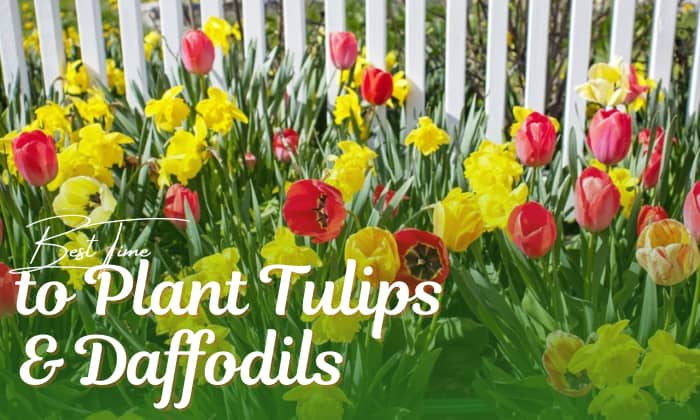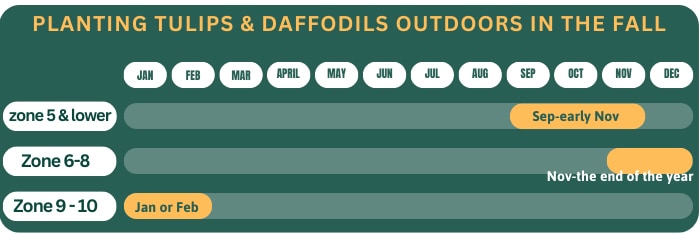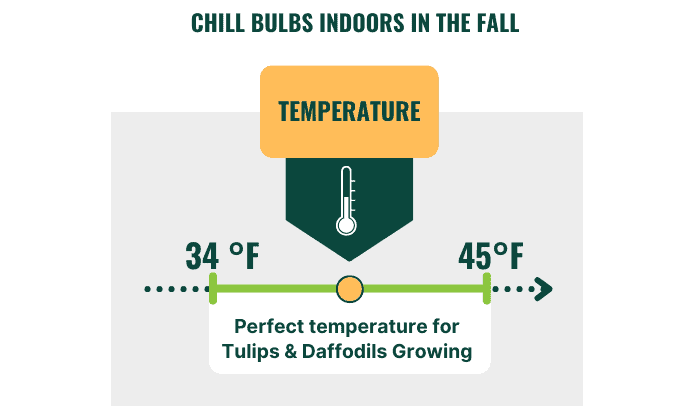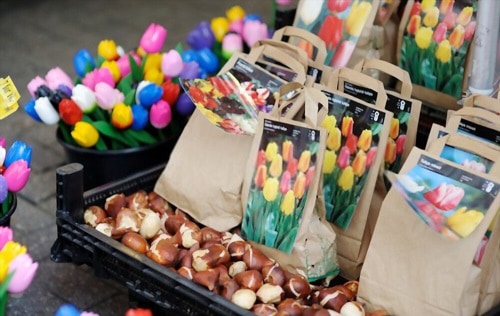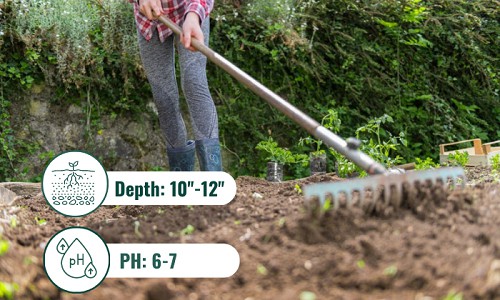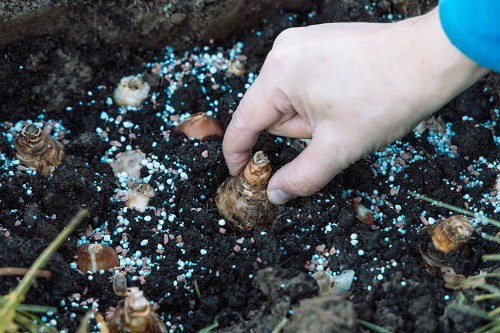Tulips and daffodils are among the best flowers you can grow in garden beds and containers. They add spectacular colors to their surroundings and are straightforward to care for, provided you know when to plant tulips and daffodils in the fall.
To plant flower bulbs like these, sow them from September to November when the weather is cool. Read below for more tips on cultivating these plants.
Table of Contents
Best Time to Plant Tulips and Daffodils
1. Plant outdoors in the fall from September to December
When can you plant tulips and daffodils? The best time of year to grow them is in the fall, about six to eight weeks before the first frost.
Following this timeline allows these bulb flowering plants to establish themselves and spread their feeder roots.
The six-to-eight-week timespan also helps them prepare for dormancy during winter and bloom in the spring. In contrast, planting daffodils and tulips together during the warm weather of summer can lead to flower deformities or no bloom altogether.
Here is the gardening time for different hardiness zones. As you can see, hotter areas like zone 9 and higher don’t have the climate required to let tulip and daffodil bulbs chill outside, which is why you must keep them indoors for a while.
- In zone 5 and lower – Plant outdoors from September to early November.
- Zone 6 to 8 – Plant in November until the end of the year.
- Zone 9 to 10 – Chill bulbs indoors in late fall (around mid-October), then plant outdoors in January or February. You can check out our recommendations for pre-chilling bulbs below.
2. Chill bulbs indoors in the fall, then plant bulbs in the spring
Tulips and daffodils must be chilled under 35 to 45℉ in the fridge if you live in a warm climate. To be specific, tulips need ten to fourteen weeks of cold temperatures, while daffodils require sixteen weeks.
All you have to do to satisfy these requirements is to put the bulbs in a soilless container mix, then water them before covering the pots with ventilated plastic bags. Keep the bulbs in pots in a fridge without ethylene gas-producing fruits and veggies (such as bananas, apples, tomatoes, melons, avocados, peaches, etc.).
You can start planting bulbs in spring once the chilling is done.
3. Planting time in different areas
Here are the months when growers can plant daffodils and tulips in different regions of the US.
| Region | When to plant bulbs |
| Arid West | September 30 – November 30 |
| Rocky Mountains | September 15 – November 1 |
| Northern Central | Mid-September – November |
| Central and Great Plains | September 30 – November 30 |
| East Central and mid-Atlantic Coast | October 1 – November 30 |
| Great Lakes and New England | Mid-September – mid-November |
| South Central and south-Atlantic Coast | Mid-October – mid-December |
| Appalachian | September 15 – November 30 |
| Gulf Coast | October 1 – December 31 |
| Northern Pacific Coast | October 1 – December 1 |
| Southern Pacific Coast | Pre-chill as described in zone 9 and 10. You can plant tulips, daffodils and hyacinths this way instead of just the first two flowers. |
4. Is it too late to plant tulips and daffodils?
It is not too late to plant spring bulbs if the ground is workable and you can dig it. This condition may be available up to January, so consider this month the final tulip and daffodil planting time.
When delaying your gardening, remember to cover the bulbs under six inches of soil or three times as much dirt as the bulbs’ height.
Tulip and Daffodil Planting Guide
1. Flower bulb types, tips for selecting healthy bulbs
Select bigger tulips and daffodils bulbs if you want stronger stems and larger flowers. The bulbs should be plump and firm, with no soft or mushy spots, discoloration, rot, or a foul smell.
Before planting, you can dunk the bulbs in water and see which ones float up. The ones that rise to the surface are unhealthy and should be discarded.
As for flower types, some daffodils worth considering are trumpet varieties like Dutch Master and Yellow River, large cups like Orange Progress and Pink Pride, or double daffodils like White Lion and Tahiti.
Tulip varieties are also numerous, including Emperor tulips that bloom in early spring, Darwin Hybrids that flower in the middle of said season, and Double Late varieties that blossom in late spring.
You can look at seed catalogs and see which type suits your hardiness zone, then purchase at least five bulbs for each variety. I recommend having ten bulbs of both flowers for the best visuals when planting tulips and daffodils together in clusters or sweeps.
2. Preparing the soil and bulbs
Remove all weeds from the planting area and loosen the soil down to a depth of 10 to 12 inches. Rake the soil to create mounds with good drainage for the bulbs.
The pH for planting should range from 6 to 7, and you can add wood ash to the ground to raise alkalinity if necessary, or use sulfur to lower it.
Next, incorporate aged compost into the soil to increase fertility.
It’s also ideal if you purchase your bulbs in August for the best quality and selection. For tips on how to store bulbs that arrived early, scroll down.
3. Proper planting technique, spacing, and depth
Use a bulb planter to drill holes into the soil. The holes should be six inches deep for both tulips and daffodils and four to eight inches apart.
The pointy tips of the bulbs should face up while their roots are at the bottom. You should then backfill the holes with soil and smooth the ground with your fingers.
Aftercare and Maintenance
Water the soil after you sow tulips and plant daffodils in clumps. Moisture should reach six inches deep into the ground to help flower roots grow. At the same time, keep the planting area damp until freezing weather comes.
With regard to irrigation, you can forget about it during winter and resume watering in spring at a rate of once per week. But if the soil is extremely dry, give the bulbs some water to help them through winter.
It is also best if you feed tulips with a 9-9-6 slow-release fertilizer after planting. Daffodils, on the other hand, will do well with a bulb food application before sowing and a dissolved 5-10-5 granular fertilizer in early spring when they resume growth.
We have listed some other tips you can follow while planting tulips and daffodils for spring flowers:
- Sow bulbs when night temperatures reach 40 to 50℉ and in a location with full sun for tulips and full to partial sun for daffodils.
- Remove the flowers once they start fading but keep the foliage intact. This step will encourage the plant to send energy towards its bulb for healthy blooms next year, which is crucial if you cannot plant daffodils in the spring (or tulips) through pre-chilling.
- Mulch the soil to protect bulbs from cold weather, especially if you sow them late.
Storing Tips for Flower Bulbs
Suppose it’s not a good time to plant bulbs where you live, and you need to store them until late fall. What can you do in this situation?
Just put the bulbs in a ventilated paper bag or box and place them somewhere dark and dry under a temperature of 60 to 65℉.
If you want to dig up your tulips and daffodils from the ground to protect them from animals, make sure to dry them for a week and apply a fungicide powder on the bulbs before storage.
Frequently Asked Questions
Are tulips and daffodils perennials?
Yes. Both plants are perennials, though external conditions may influence whether they come back in spring or not.
Tulips will not bloom a second time if they are grown in a climate too different from their natural habitat.
Daffodils also won’t perennialize if you trim their foliage before it starts to die back or give them less than six hours of direct sunlight.
How many daffodil bulbs should I plant together?
You should grow them in clusters of five or more bulbs. I prefer a somewhat circular planting pattern and not a straight line for a more natural look.
What comes up first, tulips or daffodils?
Daffodils tend to come up before tulips, with all daffodil varieties flowering from February to May, while tulips blossom from the end of March until May.
It is also not unusual for tulips to flower in April at the earliest, though a few varieties, like species tulips and Fosteriana, will shoot up before daffodils.
How long does it take for tulips and daffodils to bloom after planting?
Tulips need 12 to 14 weeks to bloom after planting, while daffodils require 13 to 19 weeks at maximum. These estimates include the chill period required for flower development.
Can I plant daffodils in March?
You can, if you live in cool regions of Australia or a country in the Southern Hemisphere like New Zealand. In these areas, fall weather is too warm for daffodils, while spring temperatures are more suitable for them.
Conclusion
Can I plant daffodil bulbs now? You can if it’s currently six to eight weeks before the first frost. The same applies to tulips if you’re growing them in the fall. Though these flowers are forgiving, it’s wise to sow them in a timely manner so that they can produce the most beautiful spring blooms.
For more questions on when to plant tulips and daffodils, send us a message.

Hi, I am William – Floridayards’ digital content creator. My job is to find answers to all your concerns with thorough research and our team’s expert advice. I will also bring you honest reviews on the best products and equipment for raising your beautiful garden. Please look forward to our work!


